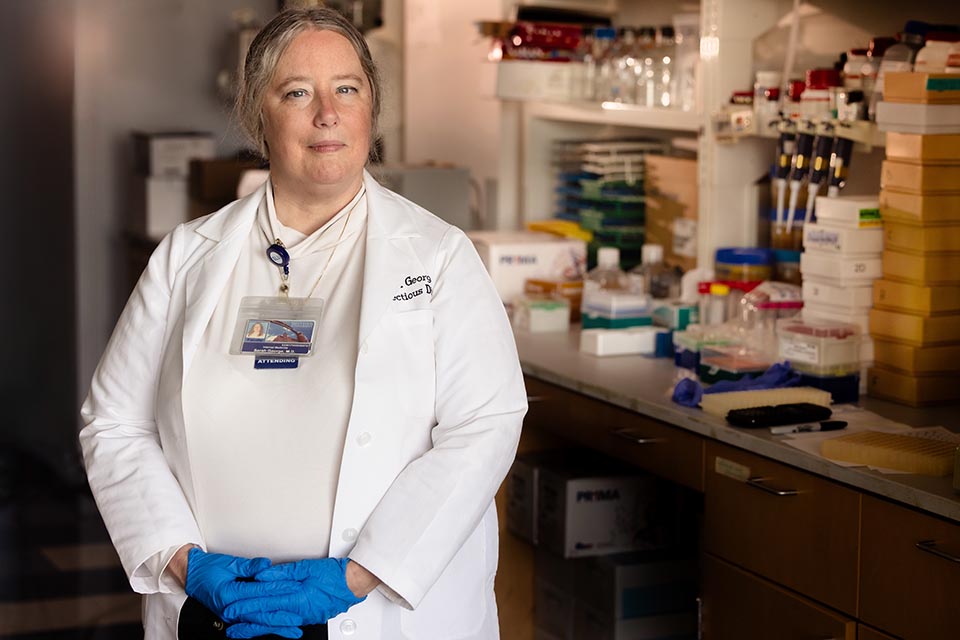Leaders Tout Teamwork for Geospatial Success in St. Louis
09/13/2024
The future of geospatial work in St. Louis is collaboration.
Thursday morning, a record crowd attended the sixth Geo-Resolution conference at Saint Louis University. The annual event, co-hosted by the National Geospatial-Intelligence Agency and SLU, was focused this year on the future — the event’s theme was "Modeling the Future for Today's Decisions."
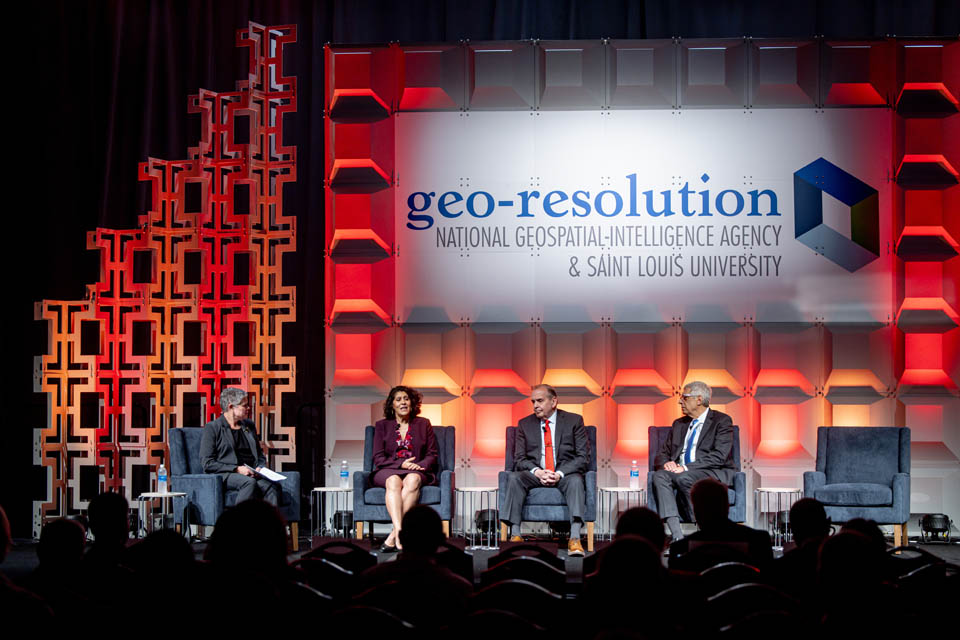
The Leaders Look panel of the Geo-Resolution Conference on Sept. 12, 2024. Photo by Sarah Conroy.
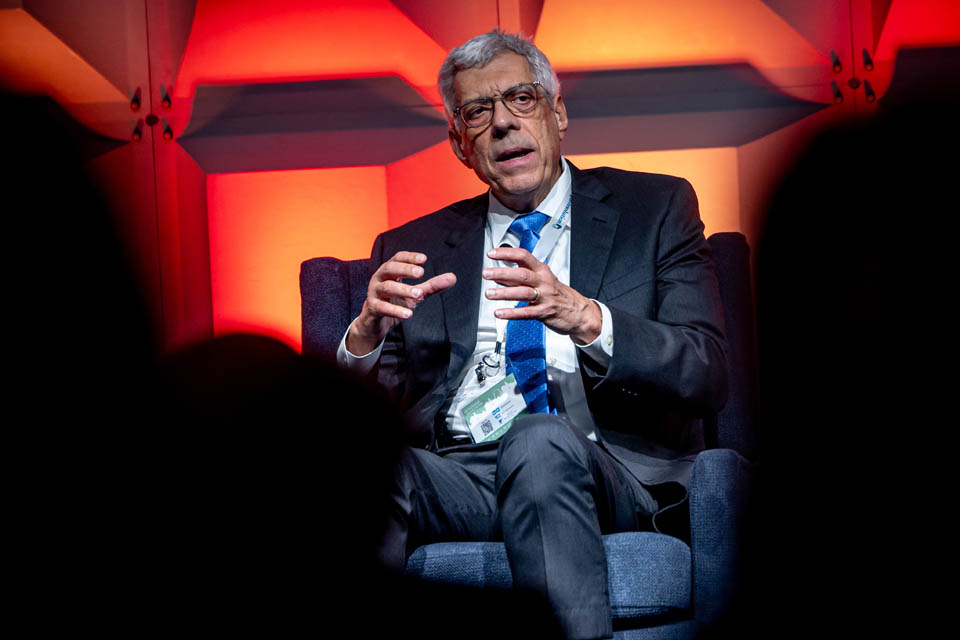
President Fred P. Pestello, Ph.D., speaks on the Leaders Look panel during the Geo-Resolution Conference on Sept. 12, 2024. Photo by Sarah Conroy.
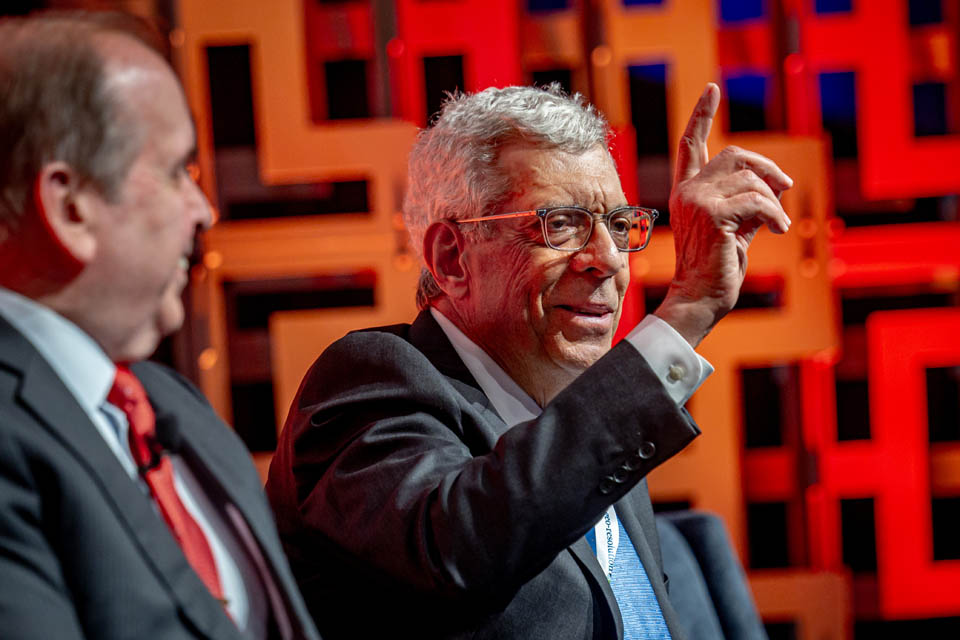
President Fred P. Pestello, Ph.D., right, speaks as William Caniano, West Executive and director of the office of corporate communications of the National Geospatial-Intelligence Agency, left, listens during the Leaders Look panel of the Geo-Resolution Conference on Sept.12, 2024. Photo by Sarah Conroy.
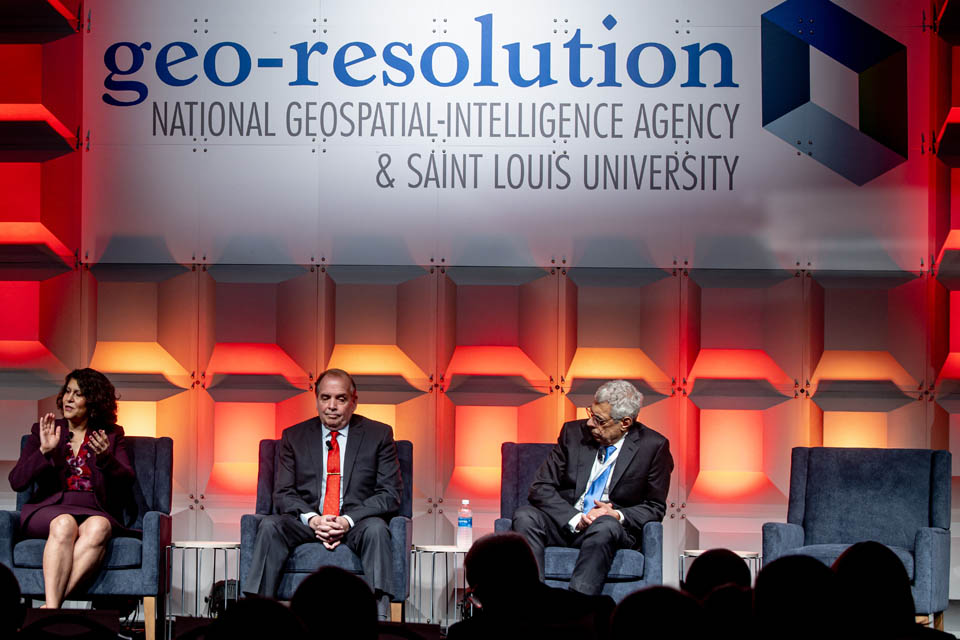
From left, Nadine Alameh, Ph.D., executive director of the Taylor Geospatial Institute, William Caniano, West Executive and director of the office of corporate communications of the National Geospatial-Intelligence Agency, and SLU President Fred P. Pestello, Ph.D., participate in the Leaders Look panel during the Geo-Resolution Conference on September 12, 2024. Photo by Sarah Conroy.

From left, Nadine Alameh, Ph.D., executive director of the Taylor Geospatial Institute, William Caniano, West Executive and director of the office of corporate communications of the National Geospatial-Intelligence Agency, and SLU President Fred P. Pestello, Ph.D., participate in the Leaders Look panel during the Geo-Resolution Conference on September 12, 2024. Photo by Sarah Conroy.
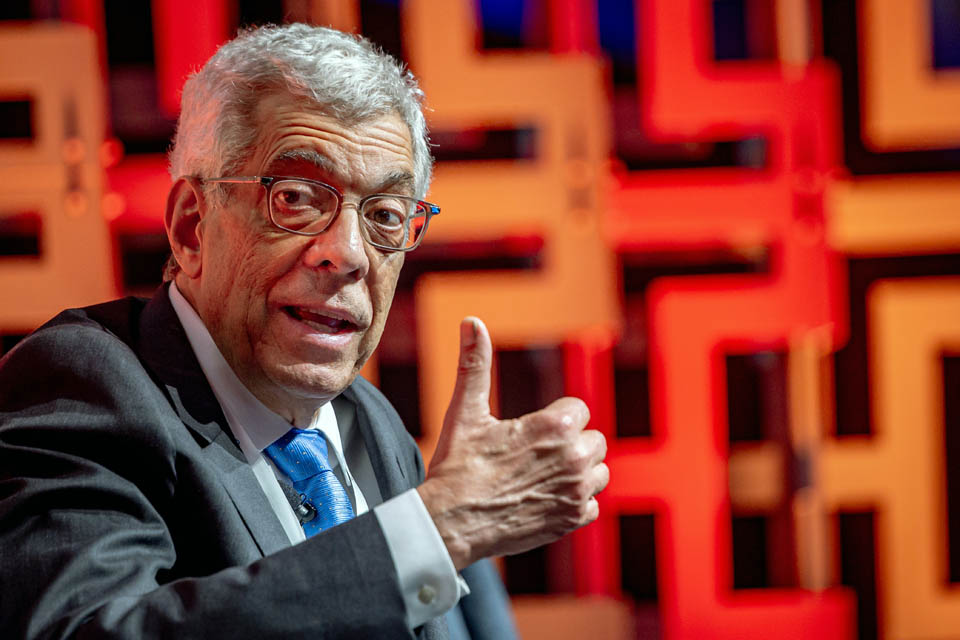
President Fred P. Pestello, Ph.D., speaks on the Leaders Look panel during the Geo-Resolution Conference on Sept. 12, 2024. Photo by Sarah Conroy.
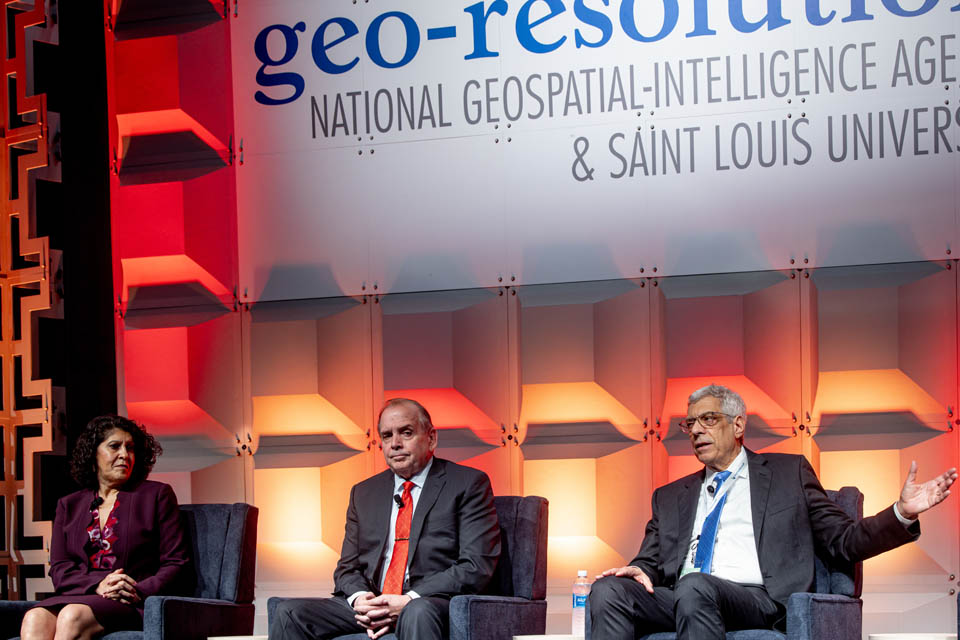
President Fred P. Pestello, Ph.D., right, speaks on the Leaders Look panel with Nadine Alameh, Ph.D., executive director of the Taylor Geospatial Institute, left, and William Caniano, West Executive and director of the office of corporate communications of the National Geospatial-intelligence Agency, center, during the Geo-Resolution Conference on September 12, 2024. Photo by Sarah Conroy.
During the conference’s opening event, the Leaders’ Look panel, SLU President Fred P. Pestello, Ph.D., Taylor Geospatial Institute Executive Director Nadine Alameh, Ph.D., and NGA West Executive and Director, Office of Corporate Communications William Caniano shared their thoughts about the current state of the geospatial industry and looked ahead. All three shared the belief that collaboration would be the key driver for a brighter future.
Caniano spoke about the collaboration between the NGA and SLU to host the annual event which has grown in popularity each year.
“Even before we made the decision to stay in St. Louis, Saint Louis University was actively engaged with us,” Caniano said. “So thanks to them for their support of this and everything that we have done together.”
Pestello noted that the relationship between the two groups made sense. The NGA needs highly-trained people to handle the massive amount of data. SLU sought to build up its geospatial program to help train those future leaders.
Alameh spoke about the ever-changing technology in the world today. With things like artificial intelligence programs, Alameh said there was more data than ever being generated. Everyone, she said, is involved with A.I.
Working for TGI, a SLU-led consortium of eight leading research institutions working together on research into geospatial technology, Alameh has a view of both the academic side of geospatial work as well as the professional aspects. From her point of view, she said moving forward the groups must work together.
“My conclusion when I look at the TGI network of academic research and the industry is that everyone is doing something with A.I.,” she said. It becomes very clear to me is the key is the partnership and the collaboration. … We cannot do this alone.”
Pestello said SLU welcomes the challenge and the collaboration.
“It is ts absolutely critical for any college or university, and we take it very seriously,” Pestello said. “We generate knowledge, we transmit knowledge, and for young people, we apply knowledge. Taking in young people, the future leaders, and the future workforce, is absolutely essential. That means having the right faculty and support staff who can invest in those people and prepare for them intellectually and cognitively, but also in terms of their entire development, so that they are prepared for what they may face in life and work post-graduation.”
All three leaders believed that St. Louis was leading the way in geospatial work. Alameh said the way to keep the momentum going is to inspire the next generation and continue to work together.
“We need to draw them to the magic that is geospatial,” she said. “. . . The NGA created a spark. Universities have created geospatial programs which led to the birth of the Taylor Geospatial Institute, and that’s going to be part of the future roadmap. From the Institute, we’re going to create ideas that hopefully spark innovation.”
Latest Newslink
- A Camp Friendship that Stirred Up Lifelong BondsIn the summer of 2005, Mary Kate Keenoy (Chaifetz Grad '22) and Genevieve Willman met at SLU's Gardens to Tables culinary camp. What started as a shared interest in cooking grew into a lasting friendship that has endured for two decades.
- Bruce Bacon, M.D.: 1949-2025Bruce Bacon, M.D., professor emeritus of internal medicine, died Sunday, July 6, 2025. He was 75. Bacon was known globally for his expertise in all aspects of clinical hepatology, specifically hemochromatosis, viral hepatitis, chronic liver disease / general hepatology, and liver transplant. Bacon was also a member of the research team that discovered the gene for hemochromatosis, HFE, in 1996.
- SLU Launches William L. Clay, Sr. Institute of Civic Engagement and Economic JusticeThe Clay Institute will provide immersive learning experiences and hands-on training that address the social and economic challenges facing the St. Louis region and the nation. Institute programming will be available to all students with an interest in civic engagement and democratic participation.
- SLU Research Explores Depression's Ripple Effect on DiabetesA study conducted by researchers at Saint Louis University found that patients with depression were more likely to have uncontrolled diabetes over time and that depression contributes to a heightened economic burden to diabetes management.
- SLU/YouGov Poll: Statewide Cell Phone Ban for Missouri Schools Popular with VotersGovernor Mike Kehoe has signed Senate Bill 68 into law, enacting a statewide ban on the use of personal electronic devices, including cell phones, tablets, and smartwatches, throughout the school day in Missouri public and public charter schools.
- SLU Vaccine Center Will Enroll Healthy Volunteers in Yellow Fever Vaccine Clinical TrialSaint Louis University's Center for Vaccine Development will enroll up to 70 adult volunteers in a clinical trial to study the safety elicited by a new investigational vaccine for yellow fever, a potentially deadly disease that is spread by mosquitoes. The research is funded by Sanofi Pasteur.













